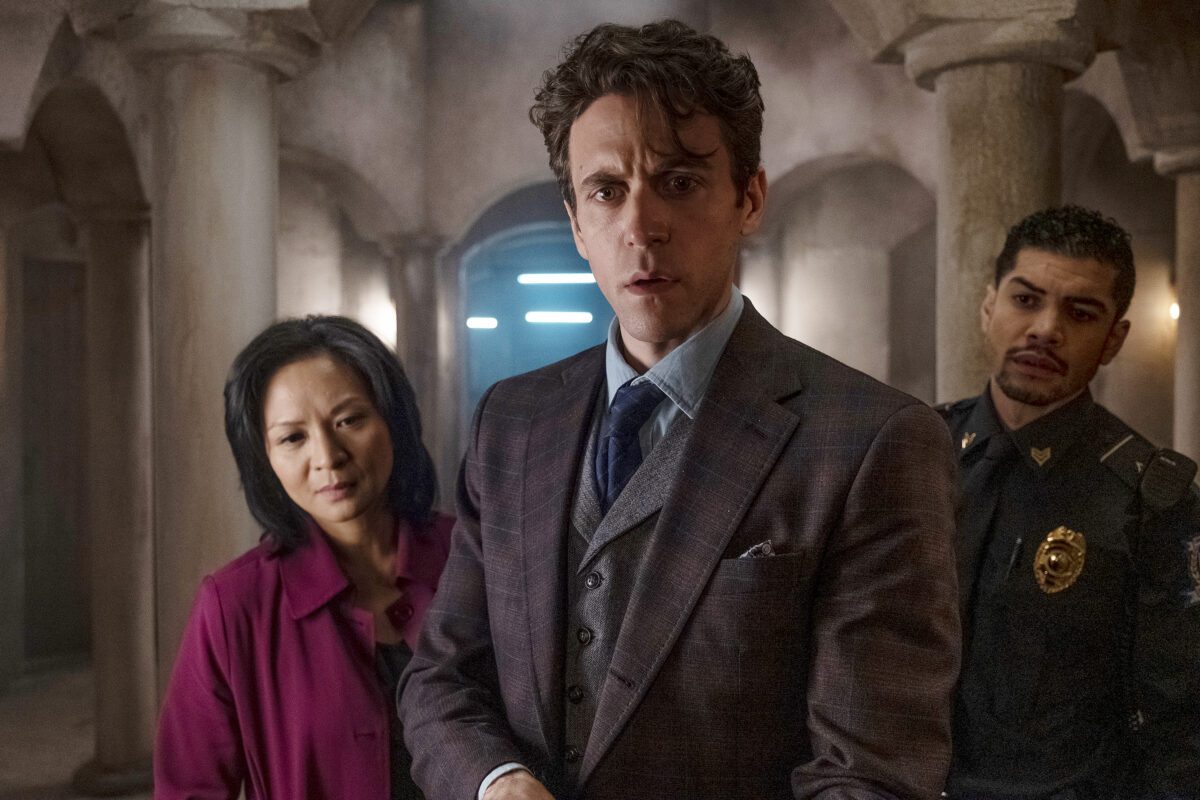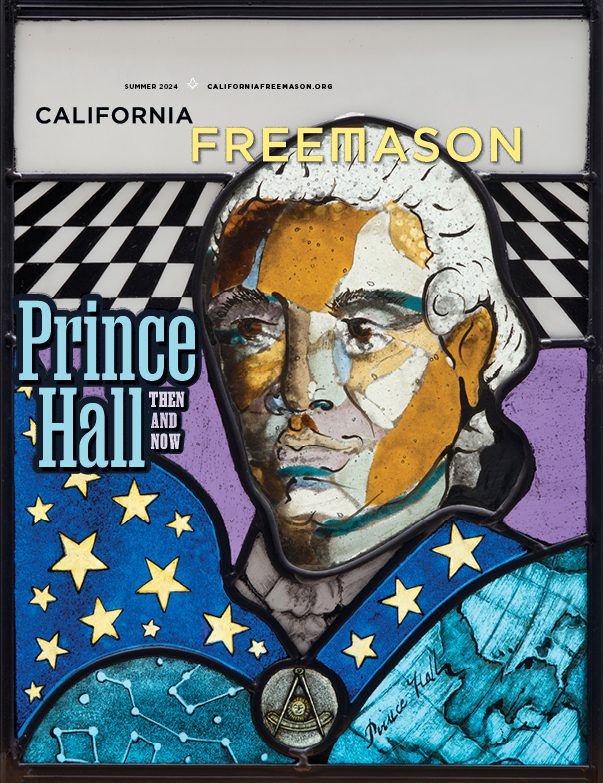A New Show Bringing Freemasonry into Prime Time
NBC Peacock series "The Lost Symbol" picks up on Dan Brown's Masonic-themed thriller.
In September, NBC’s streaming service Peacock debuted a new television adaptation of Dan Brown’s The Lost Symbol, based on the follow-up novel to the smash hit The Da Vinci Code. One of the most anticipated novels of all time, The Lost Symbol originally set several sales records when it was released in 2009—selling a million copies on its first day and staying on the New York Times bestseller list for 29 weeks.
The novel also touched off a sudden explosion of interest in Freemasonry, which provides a mysterious backdrop to the plot of the story. The term “Freemason” ended the year among the top 10 search words on Yahoo, and during a single six-week period, was the subject of 127 major-media stories, including from NBC’s Dateline and Today shows.
So, with the unveiling of the new television series, starring Ashley Zuckerman as the Harvard symbologist Robert Langdon and Eddie Izzard as the Mason-historian Peter Solomon, we decided to revisit the launch of the novel, when California Freemason‘s Cason Lane examined the story’s portrayal of the fraternity and separated facts from myths.
Below is the feature from the issue. Read the full issue here. Dan Brown’s The Lost Symbol is streaming now on Peacock, with new episodes released each Thursday.
Spotlight on Freemasonry
By Cason Lane
Today’s pop-culture conversation is full of the familiar gab on sports, movies, and politics. But there’s another topic that’s gaining ground—and in a positive way. That topic is Freemasonry.
One reason is because novelist Dan Brown is at it again with another bestseller released in September, The Lost Symbol. And this time, the dominant theme is Freemasonry—which Brown portrays as important, benevolent, historically significant, and, of course, a little mysterious.
Whereas Brown’s previous books have mentioned Freemasonry only in passing, The Lost Symbol uses the mystique of Freemasonry as the backdrop for the entire plot. In this fictional story, set in Washington, D.C., Harvard symbology professor Robert Langdon races against the clock to crack codes, uncover ancient mysteries, investigate the symbols and tenets of Freemasonry, and locate a legendary “Masonic pyramid” with the secrets to human potential.
While Brown certainly takes some dramatic license for his story, overall he is very respectful of Freemasonry, calling it “one of the most unfairly maligned and misunderstood organizations in the world.” The book goes on to make many other positive references to Masonry, such as this one:
“In this age when different cultures are killing each other over whose definition of God is better, one could say the Masonic tradition of tolerance and open-mindedness is commendable. Moreover, Masonry is open to men of all races, colors, and creeds, and provides a spiritual fraternity that does not discriminate in any way.”
At the end of the day, The Lost Symbol may well do for Masonry what Top Gun did for the Navy: send droves of men to inquire about membership.
Above:
DAN BROWN’S THE LOST SYMBOL: From “Pilot” Episode 101. Pictured from left to right, Ashley Zukerman as Robert Langdon, Sumalee Montano as Agent Sato, Rick Gonzalez as Nunez.
Sorting Fact from Fiction
While The Lost Symbol casts Freemasonry in an overall positive light, the book does include a few inaccuracies—and not surprisingly, many hail back to popular Masonic myths. Brother Brent Morris, managing editor of the Scottish Rite Journal, was asked to dispel four Masonic myths perpetuated by Brown.
False: Masons drink wine from human skulls and do other evil things as part of their degree rituals.
The first scene in The Lost Symbol features a Masonic initiate drinking wine from a human skull in the Scottish Rite House of the Temple. Morris says this ritual description can be traced back to an 1887 book called “Scotch Rite Masonry Illustrated” by Jonathan Blanchard, who believed that Masonry was evil and should be destroyed.
“He started a group called the National Christian Association dedicated to the destruction of fraternal organizations and secret societies, and he published all the rituals he could get a hold of,” Morris says.
He adds that many of the rituals that Blanchard exposed, including the drinking from a human skull, came from the Cerneau Scottish Rite, a rogue branch of Scottish Rite that was established by Frenchman Joseph Cerneau. Morris says the Cerneau Scottish Rite operated in direct competition with the Scottish Rite’s Southern and Northern Masonic jurisdictions until about 1890, when it finally died out.
False: The 33rd degree is the pinnacle of Freemasonry.
The Lost Symbol makes a common mistake by confusing the degrees of Freemasonry and the Scottish Rite. For example, Brown portrays one of his central characters as a 33rd degree Mason, part of the “highest echelon of the world’s oldest surviving brotherhood,” where only an elite few members know the secrets of mankind.
The truth, of course, is that there’s no Masonic degree of higher rank or importance than the third degree, that of the Master Mason. Contrary to The Lost Symbol, a Mason with the 33rd degree is not at the zenith of all Freemasonry but instead has gained an honorary title within the Scottish Rite, recognizing his significant contribution to society or Masonry in general.
Brown has fun with the origin of the 33rd degree, suggesting that the number was chosen because Jesus was 33 years old when he was crucified, God is mentioned 33 times in the book of Genesis, there are 33 vertebrae in the spine, and so on. True? Morris says the reason for the number 33 is a mystery.

False: There is a Masonic pyramid in Washington, D.C., that leads to “ancient mysteries” buried long ago.
Morris says that despite age-old beliefs to the contrary, the pyramid is not a fundamental part of Masonic symbolism, and there is no Masonic pyramid—be it a building, a map, or a handheld object—that leads to lost wisdom as described in The Lost Symbol.
“Part of this goes back to the long-held belief that the Great Seal of the United States secretly contains Masonic emblems and that the uncompleted pyramid with the all-seeing eye is a Masonic emblem,” Morris says.
He adds that the Great Seal myth is promoted not only by naive non-Masons, but also by mistaken Masons who think it’s a cool story. The truth, Morris explains, is that three committees designed the Great Seal, and the only Masonic committee member, Benjamin Franklin, contributed no Masonic emblems to the design process. Furthermore, both the uncompleted pyramid and the all-seeing eye were added by non-Masons.
As for the ancient mysteries, The Lost Symbol suggests that Masons are the last remaining of secret fraternities that were developed to protect this mystical wisdom, said to contain power for elevating man to the realm of the gods.
“The ancient mysteries generally refer to a series of religious practices in the Mediterranean Basin,” Morris says. “These were basically religious fraternities where you would go through an initiation process. At one time there was a theory that Freemasonry was a descendant of the ancient mysteries, because here you have a fraternity… and they’re teaching their members to know more about God and the world and themselves. But it turns out that while that’s a nice theory, there is no historical connection.”
False: To hide the ancient mysteries, early Freemasons used an encoded language called the “Masonic cipher” that was legible only to the worthy.
Morris says that by 1745, Freemasons had started using a cipher, which he describes as essentially a tic-tac-toe grid with the letters of old-world alphabets. But that cipher was used merely as a symbolic gesture, not as a secret language. Today, he adds, a Mason might be shown how to use the cipher as part of receiving, say, a Royal Arch degree. “It’s very much like giving you a key to the city,” Morris says. “The key to the city doesn’t really unlock anything. It’s a symbolic presentation.”
Above:
DAN BROWN’S THE LOST SYMBOL: From “Pilot” Episode 101. Pictured from left to right, Ashley Zukerman as Robert Langdon, Edward Izzard as Peter Soloman
PHOTOGRAPHY CREDITS:
Courtesy of Rafy/Peacock
